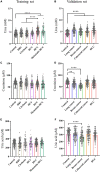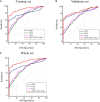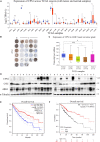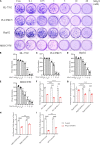Urea as a By-Product of Ammonia Metabolism Can Be a Potential Serum Biomarker of Hepatocellular Carcinoma
- PMID: 33869206
- PMCID: PMC8047217
- DOI: 10.3389/fcell.2021.650748
Urea as a By-Product of Ammonia Metabolism Can Be a Potential Serum Biomarker of Hepatocellular Carcinoma
Abstract
Hepatocellular carcinoma (HCC) is highly malignant; nearly half of the new cases and deaths are in China. The poor prognosis of HCC is mainly due to late diagnosis; many new biomarkers have been developed for HCC diagnosis. However, few markers are quickly translated into clinical practice; early and differential diagnosis of HCC from cirrhosis and/or hepatitis is still a clinical challenge. Metabolomics and biochemical methods were used to reveal specific serum biomarkers of HCC. Most of the elevated metabolites in HCC and HBV patients were overlapped compared with controls. Urea was the specifically elevated serum biomarker of HCC patients. Moreover, urea combined with AFP and CEA can improve the sensitivity of HCC diagnosis. The plasma ammonia of HCC patients was significantly higher than healthy controls. Co-culture cell model revealed normal liver cells cooperated with cancer cells to metabolize ammonia into urea. The urea metabolism in cancer cells marginally depended on the expression of CPS1. However, the expression of CPS1 did not change with ammonium chloride, which might regulate the urea cycle through enzyme activity. The urea cycle could detoxify high concentrations of ammonia to promote cancer cell proliferation. Therefore, urea was a by-product of ammonia metabolism and could be a potential serum biomarker for HCC. The combined application of metabolomics and biochemical methods can discover new biomarkers for the early diagnosis of HCC and be quickly applied to clinical diagnosis.
Keywords: CPS1; ammonia; biomarker; hepatocellular carcinoma; metabolomics; urea.
Copyright © 2021 Bai, Wang, Dong, Li, Yu, Guo, Zhou, Li, Yan, Wang, Wang, Li and Ren.
Conflict of interest statement
The authors declare that the research was conducted in the absence of any commercial or financial relationships that could be construed as a potential conflict of interest.
Figures







Similar articles
-
Serum DKK1 as a protein biomarker for the diagnosis of hepatocellular carcinoma: a large-scale, multicentre study.Lancet Oncol. 2012 Aug;13(8):817-26. doi: 10.1016/S1470-2045(12)70233-4. Epub 2012 Jun 26. Lancet Oncol. 2012. PMID: 22738799
-
Metabolomics and eicosanoid analysis identified serum biomarkers for distinguishing hepatocellular carcinoma from hepatitis B virus-related cirrhosis.Oncotarget. 2017 Jul 10;8(38):63890-63900. doi: 10.18632/oncotarget.19173. eCollection 2017 Sep 8. Oncotarget. 2017. PMID: 28969038 Free PMC article.
-
Assessment of high-sensitivity C-reactive protein tests for the diagnosis of hepatocellular carcinoma in patients with hepatitis B-associated liver cirrhosis.Oncol Lett. 2017 May;13(5):3457-3464. doi: 10.3892/ol.2017.5890. Epub 2017 Mar 22. Oncol Lett. 2017. PMID: 28521452 Free PMC article.
-
Deciphering hepatocellular carcinoma through metabolomics: from biomarker discovery to therapy evaluation.Cancer Manag Res. 2018 Apr 11;10:715-734. doi: 10.2147/CMAR.S156837. eCollection 2018. Cancer Manag Res. 2018. PMID: 29692630 Free PMC article. Review.
-
New Blood Biomarkers for the Diagnosis of AFP-Negative Hepatocellular Carcinoma.Front Oncol. 2020 Aug 14;10:1316. doi: 10.3389/fonc.2020.01316. eCollection 2020. Front Oncol. 2020. PMID: 32923383 Free PMC article. Review.
Cited by
-
Metabolomics-Guided Identification of a Distinctive Hepatocellular Carcinoma Signature.Cancers (Basel). 2023 Jun 18;15(12):3232. doi: 10.3390/cancers15123232. Cancers (Basel). 2023. PMID: 37370840 Free PMC article.
-
Circulating Metabolic Markers Related to the Diagnosis of Hepatocellular Carcinoma.J Oncol. 2022 Dec 9;2022:7840606. doi: 10.1155/2022/7840606. eCollection 2022. J Oncol. 2022. PMID: 36532884 Free PMC article. Review.
-
Disturbances in Nitric Oxide Cycle and Related Molecular Pathways in Clear Cell Renal Cell Carcinoma.Cancers (Basel). 2023 Dec 11;15(24):5797. doi: 10.3390/cancers15245797. Cancers (Basel). 2023. PMID: 38136342 Free PMC article. Review.
-
Metabolic Reprogramming and Its Relationship to Survival in Hepatocellular Carcinoma.Cells. 2022 Mar 22;11(7):1066. doi: 10.3390/cells11071066. Cells. 2022. PMID: 35406630 Free PMC article.
-
Spatiotemporal modulation of SMAD4 by HBx is required for cellular proliferation in hepatitis B-related liver cancer.Cell Oncol (Dordr). 2022 Aug;45(4):573-589. doi: 10.1007/s13402-022-00683-8. Epub 2022 Jun 18. Cell Oncol (Dordr). 2022. PMID: 35716259
References
-
- Ahn J. C., Teng P. C., Chen P. J., Posadas E., Tseng H. R., Lu S. C., et al. (2020). Detection of circulating tumor cells and their implications as a novel biomarker for diagnosis, prognostication, and therapeutic monitoring in hepatocellular carcinoma. Hepatology 73 422–436. 10.1002/hep.31165 - DOI - PMC - PubMed
-
- Braissant O. (2010). Ammonia toxicity to the brain: effects on creatine metabolism and transport and protective roles of creatine. Mol. Genet. Metab. 100(Suppl. 1) S53–S58. - PubMed
LinkOut - more resources
Full Text Sources
Other Literature Sources

